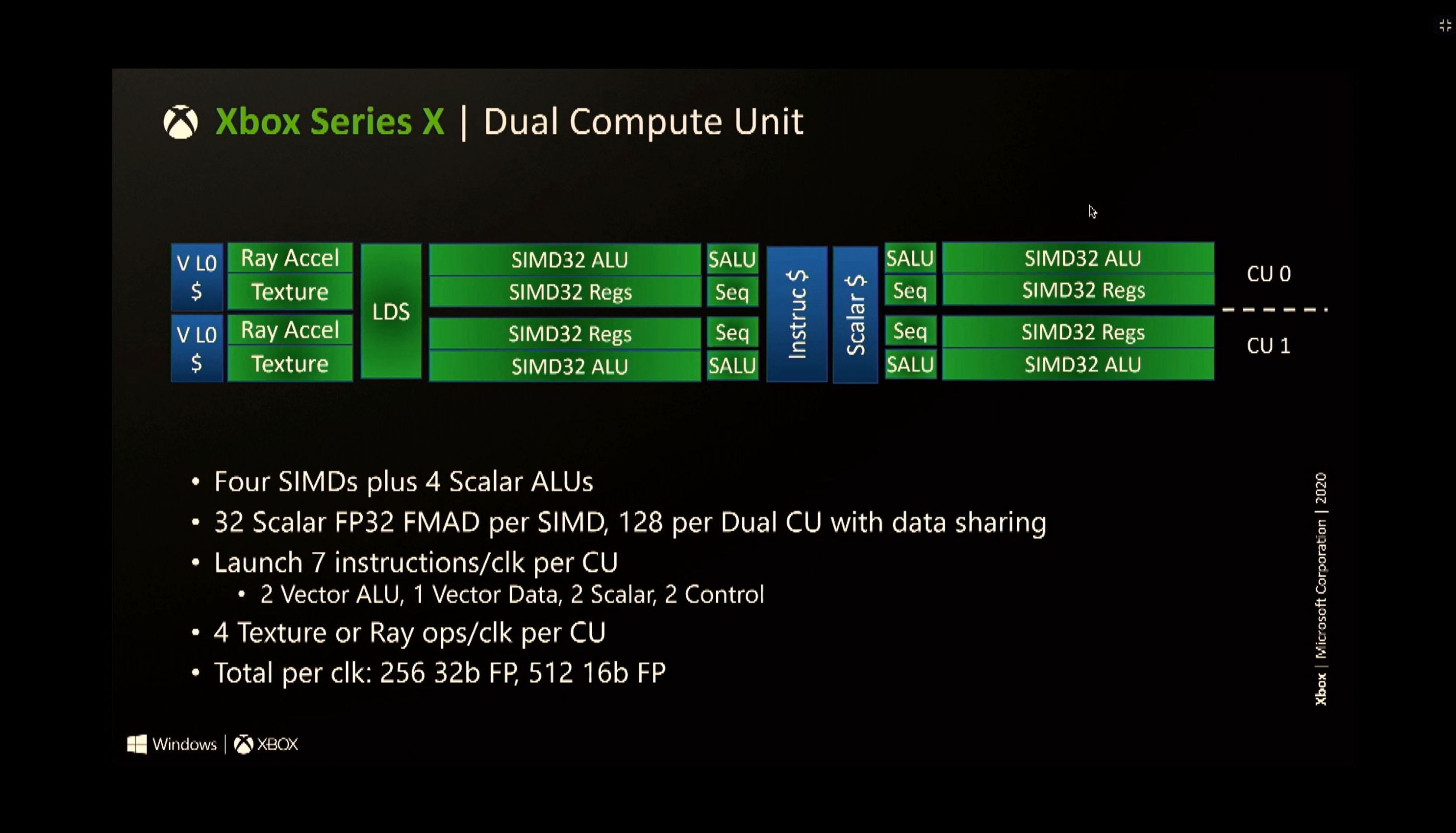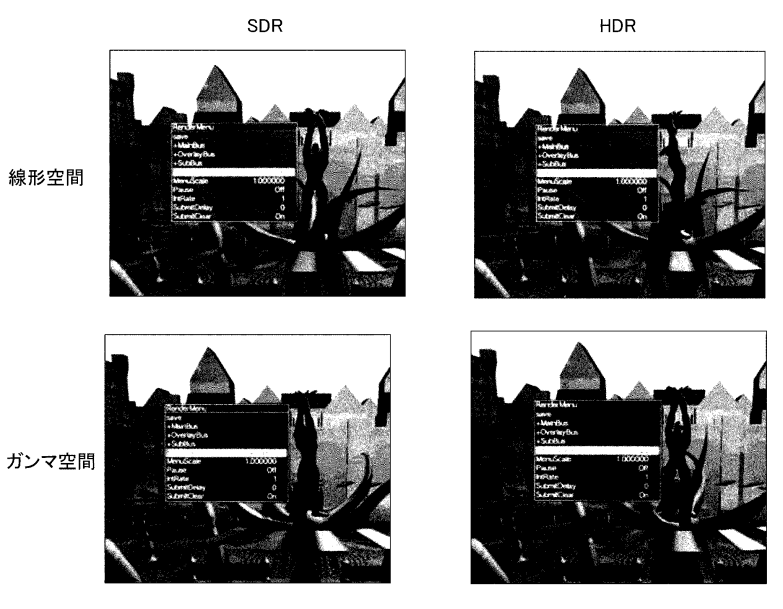kyliethicc
Member
Same as RDNA1 and PS4/5.They seem to have opted for a maximum of 5 DCUs per shader array in that arrangement.???
Same as RDNA1 and PS4/5.They seem to have opted for a maximum of 5 DCUs per shader array in that arrangement.???


Did AMD add an RA to free up the 4 TMUs? Does that give RDNA2 CUs 4 texture + 1 ray op per clock?
This.. ^ Anyone who has worked in PR knows how important those specific words are....
So it isn't possible to have lower amounts of Infinity Cache? Like 32MB, 16 or even 8MB?
Also people are sleeping on "Cache Scrubbers" that Cerny specifically mentioned as exclusive to PS5 in his presentation.
NAVI 21 (RDNA 2 full chip) uses 4 SEs, 2 SAs per SE, 5DCUs (10CUs) per SA.They seem to have opted for a maximum of 5 DCUs per shader array in that arrangement.???
Also, "pervasive fine-grain clock gating". Sounds familiar too."Redesigned Data Paths for Efficient Movement"
Reminds of what Mark Cerny said during his 'Road to PS5' talk:
"Redesigned Data Paths for Efficient Movement"
Reminds of what Mark Cerny said during his 'Road to PS5' talk:
I felt a bit stupid after noticing this (mainly because I didn't read the entire article from the start).
This.. ^ Anyone who has worked in PR knows how important those specific words are....And just like literally everything else we’ve seen so far from Microsoft, they’ve been all talk and PR spin and no substance.. (besides backwards compatibility and faux HDR that my 3 year old TV does).
What does clock gating mean? I know it helps them achieve over 2 GHz sustained clk speeds even on an 80 CU GPU. But I don't get the 'gating' part.Also, "pervasive fine-grain clock gating". Sounds familiar too.
Ok, so they are lying when they say they are using the full rdna2 architecture and they waited for rdna2 to be developed to choose RDNA1 CUs, that really makes sense, you are rightLOL., you think XSX has frequency adjustment down to each CU to acheive high clocks ? What ?
And then you think MS just turned it off because sustained sounds better, and turned down the frequency by 20-30 % lol
Really ? Thats being silly.
What about the CU looking like a 5700 and nothing like a 6800 ? Maybe we all cannot see ?
XSX has more CU but they are not same as PC parts or ps5.

Both are the exact same thing. The Amd diagram shows 1 ray accelerator per compute unit, and the Xbox diagram shows 1 ray accelerator per compute unit.

Did AMD add an RA to free up the 4 TMUs? Does that give RDNA2 CUs 4 texture + 1 ray op per clock?
Likewise, is XSX's RDNA implementation limited to either texture or ray ops, or can it be a mix of 4/0, 3/1, or 2/2 op splits per clock?
I'm wondering if the PS5 CUs have separated the ray accelerator from the TMUs, or if it repurposes TMUs as RAs.
Does this mean that the XSX can process more rays per clock than the PC part, but at the loss of texturing capacity? I didn't see anything about how many rays ops an be processed per clock for the PC cards, and just assumed it was 1, though it might well be 4 per CU.
Oh shit! I'm late to the party! Hey guys....

Well, well, well...ain't this place a bitch.
I guess PS5 doesn't have infinity cache? Or maybe we still don't know yet? I dunno. Whatever. Seems like the usual assholes on Twitter are arguing over which console is "true" RDNA2. At some point they (certain Xbox fanboys on Twitter in particular) will realize RDNA2 is a foundation and how it's built upon matters most.
Nop Xbox diagram show ray accelerator use TMU for calculate. AMD diagram Show you can use RT accelerator & 4TMU at the same time.Both are the exact same thing. The Amd diagram shows 1 ray accelerator per compute unit, and the Xbox diagram shows 1 ray accelerator per compute unit.

What does clock gating mean? I know it helps them achieve over 2 GHz sustained clk speeds even on an 80 CU GPU. But I don't get the 'gating' part.
Now, can this go down to individual stream processors, or will that potentially be a rumored RDNA3 feature?Pervasive fine grain clock gating, whcih I guess will be datailed more in white paper. But its fine fequency control IMO.



Essentially It refers to the logic gates of which all processors are built on. The clock controls the speed of all transistor gates to keep the chip in sync and all gates at the same speed.
The pervasive-fine grain clock gating to me could mean selective groups of gates receiving different clock rates depending on workload. Or in a broader sense the GPU could select specific CUs to be clocked higher/lower for a specific task to more efficiently control power usage.
The TMU is part of the compute unit, the AMD diagram makes no claims if a RA and TMUs can be used at the same time. Please point out where this is claimed.Nop Xbox diagram show ray accelerator use TMU for calculate. AMD diagram Show you can use RT accelerator & 4TMU at the same time.

I don't think that's the case. XSX slide shows 4 texture or 4 ray ops per clock, which aligns with the 4 TMUs per CU. I'm just not sure if it's an all or nothing thing per clock. Maybe each CU can handle 1 ray op + 3 texture op per clock, or any other permutation of 4 ops. I'm not really clear on that. The slide from today appears to clearly separate the ray accelerator from the TMUs, as the TMUs are still visible as 4 texture filter units, and 4 texture mapping units, to the right of the ray accelerator.Both are the exact same thing. The Amd diagram shows 1 ray accelerator per compute unit, and the Xbox diagram shows 1 ray accelerator per compute unit.
Amazon still doesn't have a ship date. Who around here is tight with Bezos? I just wanna talk...Got my Pulse 3D Headset today from Sony direct store. Shipped and delivered in just 24 hours.
Ok, so they are lying when they say they are using the full rdna2 architecture and they waited for rdna2 to be developed to choose RDNA1 CUs, that really makes sense, you are right
You're debating with someone who has a brain as their avatar, how can you compete?I don't think that's the case. XSX slide shows 4 texture or 4 ray ops per clock, which aligns with the 4 TMUs per CU. I'm just not sure if it's an all or nothing thing per clock. Maybe each CU can handle 1 ray op + 3 texture op per clock, or any other permutation of 4 ops. I'm not really clear on that. The slide from today appears to clearly separate the ray accelerator from the TMUs, as the TMUs are still visible as 4 texture filter units, and 4 texture mapping units, to the right of the ray accelerator.
That's because it removes two arrays ( each 10 CUs) my friend. So 128 - 32=96.
ROPs - 96!!!!
Perhaps the 80 ROPs for Xbox Series X was right all along.
I debated this a couple of month ago and got called a fanboy and stupid for even suggesting the idea that Xbox Series X could have more than 64 ROPs.
Well now the RX 6800 has 60 CUs and 96 ROPs (cut down from the bigger cards - 80 and 72 CUs with 128 ROPs).
Basically variable clocks....
Variable clocks but instead of the whole GPU shifting clocks up and down, it's different parts of the chip simultaneously running at different speeds.
Rudimentary example:
Say the frame time is 16.67 (60fps)
GPU task 1 could complete in only 4 ms with lots of idle time after, so the portion of the GPU tasked with those operations could down clock to say 1500mhz and still finish within the time it takes to render the frame.
GPU task 2 needs 16ms to complete work, these cu's stay at 2230mhz and finish work in time for the frame target.
All very interesting possibilities...If only Sony would open up on the their implementations and customisiations. I guess they are too busy eating their popcorn right now though.
From reports, none have it.Super confused. Do any of the next gen consoles have infinity cache?
What reports?From reports, none have it.
NoSuper confused. Do any of the next gen consoles have infinity cache?
No.Super confused. Do any of the next gen consoles have infinity cache?
Both are the exact same thing. The Amd diagram shows 1 ray accelerator per compute unit, and the Xbox diagram shows 1 ray accelerator per compute unit.
What reports?
i don't get you Don, you come across as normal even likable when you chat like a normal person. What is it with all the triggered emotes?
He's hungry, he likes Filet O Fish, and you still swimming?
The TMU is part of the compute unit, the AMD diagram makes no claims if a RA and TMUs can be used at the same time. Please point out where this is claimed.
Hotchip conference does not ever mention it, not even in the die shot.
For the PS5, Yuko declared that it does not have infinity cache.
At the moment no console uses Infinity Cache
You can make that assumption, but that is all that it is. The only conclusion that can be drawn at this point is that Sony "clearly" has games further along than MS. Judging future capability based solely on a launch window lineup is futile.Custom RDNA2 > RDNA2. MS clearly wanted to keep unity with PC,they are releasing games day on on there. PS5 clearly has the upper hand at this point,the games and RT at launch clearly show that.
I'm not sure why people are so excited, we have known xbox has VRS for months, we saw it in Halo. We just need to know Sonys custom solutions.
